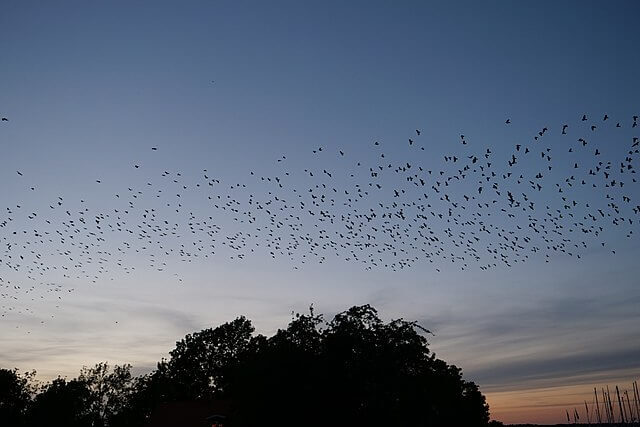
Conservationists are optimistic about the potential return of thousands of starlings to roost beneath Belfast’s iconic Albert Bridge, as efforts to minimise light pollution provide hope for the beloved birds’ comeback.
This bridge has long been a magnet for enthusiastic crowds who gather to witness and capture the mesmerising spectacle of starling murmurations, a breathtaking display of these birds in synchronised flight. However, there were concerns that changes in street lighting might have contributed to the displacement of these starlings.
In response to these concerns, blackout screens have been thoughtfully installed on the lanterns adorning the bridge, curtailing the extent of light pollution in the area.
Conor McKinney, a dedicated conservationist, reported that lighting adjustments have also been made, and he cautiously expresses his optimism for the starlings’ return. He said: “We now have less lighting on the underside of the bridge.
“We have red filters on the lights on the side of the bridge, and we also have blanking screens on the lanterns at the top of the bridge,” he said.
The Department for Infrastructure (DfI), responsible for the bridge’s lighting, took the initiative to fit the blackout screens in line with British and EU safety and environmental standards after upgrading the bridge in 2019. Simultaneously, the Department for Communities (DfC) has been tasked with managing the lights beneath the bridge to create a more wildlife-friendly environment.
At the time of the starlings’ disappearance, concerns arose that not only lighting alterations but also factors like urban development and climate change might have played a role in their displacement.
McKinney said that “light pollution was leading to the desertion of a very important roosting site”.
“As soon as it was reported that the murmuration had not returned in the same numbers as historic years, they (the relevant departments) have paid attention and have now taken action.,” he said.
Dfl emphasised their commitment to biodiversity.
“In order to minimise the impact of the parapet mounted decorative lighting in the area of the Albert Bridge, black out screens were fitted to the rear of the lanterns,” a spokesperson said.
“This work was completed last weekend.”
DfC said it wanted to encourage wildlife in the city.
“DfC, in common with its partners, stakeholders and the wider community on the River Lagan, takes its commitment to biodiversity seriously,” a spokesperson said.
“This is in relation to both development on the surrounding banks and stewardship of the river itself, and includes a range of ongoing projects and initiatives to encourage wildlife in the area.”
Murmurations, where thousands of starlings perform aerial acrobatics in unison, are a remarkable natural phenomenon. They serve various purposes, such as confusing predators, maintaining warmth, and sharing vital information about feeding locations. These captivating displays have even gained recognition on popular TV programs like BBC’s Countryfile and The One Show.
“I moved into the area at the start of 2020 when the murmuration was still a massive display across the Belfast skyline,” they said.
“One of the main draws to moving into the area was being able to sit at the window at on winter nights watching the starlings fly from across Belfast and beyond to join in the murmuration as they roosted for the night.
“With Harland & Wolff in the background it has always been one of Belfast’s most amazing sights.”
Local residents and bird enthusiasts eagerly await the starlings’ return. While the experts remain cautiously optimistic, whether the starlings will grace the Albert Bridge with their awe-inspiring presence again is still uncertain. Conor McKinney, among others, holds out hope for the return of this spectacular natural spectacle, making it a thrilling yet uncertain coin toss.
“We are still seeing very small numbers of starlings utilising this site in small groups,” he said.
“Hopefully that is sufficient to say that whenever larger numbers return to the city, we will begin to see larger groups back here and get the murmuration back up to the size that it was before.
“But we can only watch and wait.
“Moving forward, we need to recognise all of our important wildlife sites and make sure they are mapped and identified with local planning authorities and that they are being seriously considered during every single development.”
——————————————————————————
At Natural World Fund, we are passionate about stopping the decline in our wildlife.
The decline in our wildlife is shocking and frightening. Without much more support, many of the animals we know and love will continue in their decline towards extinction.
When you help to restore a patch of degraded land through rewilding to forests, meadows, or wetlands, you have a massive impact on the biodiversity at a local level. You give animals a home and food that they otherwise would not have had, and it has a positive snowball effect on the food chain.
We are convinced that this is much better for the UK than growing lots of fast-growing coniferous trees, solely to remove carbon, that don’t actually help our animals to thrive.
This is why we stand for restoring nature in the UK through responsible rewilding. For us, it is the right thing to do. Let’s do what’s right for nature!
Donate today at https://naturalworldfund.com/ and join in the solution!

